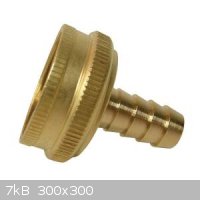
GreenDao - 15-8-2013 at 12:30
What methods/devices do any of you use for connecting the water-jacketed condenser of a distillation apparatus to a sink faucet, rather than a lab fit
one?
subsecret - 15-8-2013 at 13:05
What does the end of the faucet look like? Is it the same thread as a garden hose? If not, you can buy an adapter that replaces the aerator. After
you've given it a garden hose thread, get a garden hose to pipe thread converting fitting (Garden hose on one side, normal female thread on the
other). Then just buy a metal or plastic hose barb and screw it in. You can find these at just about any hardware store in the US.
But you don't really need to do this. You can just buy a bucket and a pond pump to cool your condenser. Pump the water through the condenser and back
into the bucket. Adding ice is a good idea.
http://www.youtube.com/watch?v=3b8cuMpBcQ0
Hope this helps.
[Edited on 15-8-2013 by Awesomeness]
[Edited on 15-8-2013 by Awesomeness]
elementcollector1 - 15-8-2013 at 13:30
To be fair, I prefer the hose over the pump simply because every house I've been to has a hose.
subsecret - 15-8-2013 at 14:54
This is true, the hose is very easy to set up. Depending on how long your experiment will be running, the bucket setup will probably save water. You
can also get colder water with the bucket approach.
Metacelsus - 15-8-2013 at 17:01
The bucket approach was what I used before my pump broke. The advantage was that I could put ice in the cooling water; the disadvantage was that the
water leaving the condenser was warm and heated the cooling supply. When using a hose, the temperature is stable, but cannot go as low. The bucket
approach does save water, but water is cheap (at least where I live).
smaerd - 15-8-2013 at 18:24
Solution to warm water, add ice periodically. Doing refluxes for 12-24 hours with a sink on full-blast is a bit ridiculous even if water is cheap.
[Edited on 16-8-2013 by smaerd]
Oscilllator - 15-8-2013 at 23:43
I do all my distillations outside as a replacement for a fume hood, and so I use my garden hose. It isn't quite the right size for the condenser, but
a bit of PTFE tape wrapped around the end of the condenser fixes this admirably  .
.
Also, because I have a water tank, water isn't just cheap, its free  . But the
water pressure is quite low so I will need a water pump when my aspirator arrives.
. But the
water pressure is quite low so I will need a water pump when my aspirator arrives.
sonogashira - 16-8-2013 at 02:07
One can buy shower-head attachments to be used with normal bathroom sinks. They have rubber ends that are meant to fit over the hot and cold taps.
[Edited on 16-8-2013 by sonogashira]
I Like Dots - 20-8-2013 at 18:01
Ok, This is what i do.
Now in most sinks, on the head of the faucet there is a thing that scews into the faucet. It has a screen to filter the water, and it also airates the
water. Unscrew this. Now take your tubing and wrap the end of it in electrical tape so it fits nice and snug into the opening.
If you look for it, there is an adapter that screws on sinks made for filling up water balloons, and guess what? it has the same fitting as your
condenser!
Gooferking Science - 21-8-2013 at 17:18
I prefer using a pump and a bucket, so that less water is wasted by just pumping it through and out the condenser with a hose or faucet. To my
knowledge, pumps run pretty cheap. I bought a hose adapter that fit the output of my pump, otherwise the hose didn't fit the pump.
Hockeydemon - 22-8-2013 at 00:27
Why would anyone use a hose over a pump? You can find a 3L/min pond pump on amazon for $12, and buckets are everywhere. Even if you're on a well -
that well uses a water pump that I guarantee uses more energy than a 12V pond pump. If you pay for water you'll save so much using a pump.
Just seems superfluously wasteful to use a running water source.
ElizabethGreene - 22-8-2013 at 06:53
I use a hose barb from Home Depot.
http://www.homedepot.com/p/Watts-3-4-in-x-1-2-in-Brass-Femal...
$10 is absolutely ludicrous, but I bought it anyway.

For connecting to a sink faucet, I can't be much help. Most kitchen sinks have a sprayer on them, and that sprayer disassembles to reveal a flexible
plastic hose. That would be where I'd start.... if this didn't violate the "No chemistry in the food preparation area" rule.
[Edited on 22-8-2013 by ElizabethGreene]

 .
. . But the
water pressure is quite low so I will need a water pump when my aspirator arrives.
. But the
water pressure is quite low so I will need a water pump when my aspirator arrives.